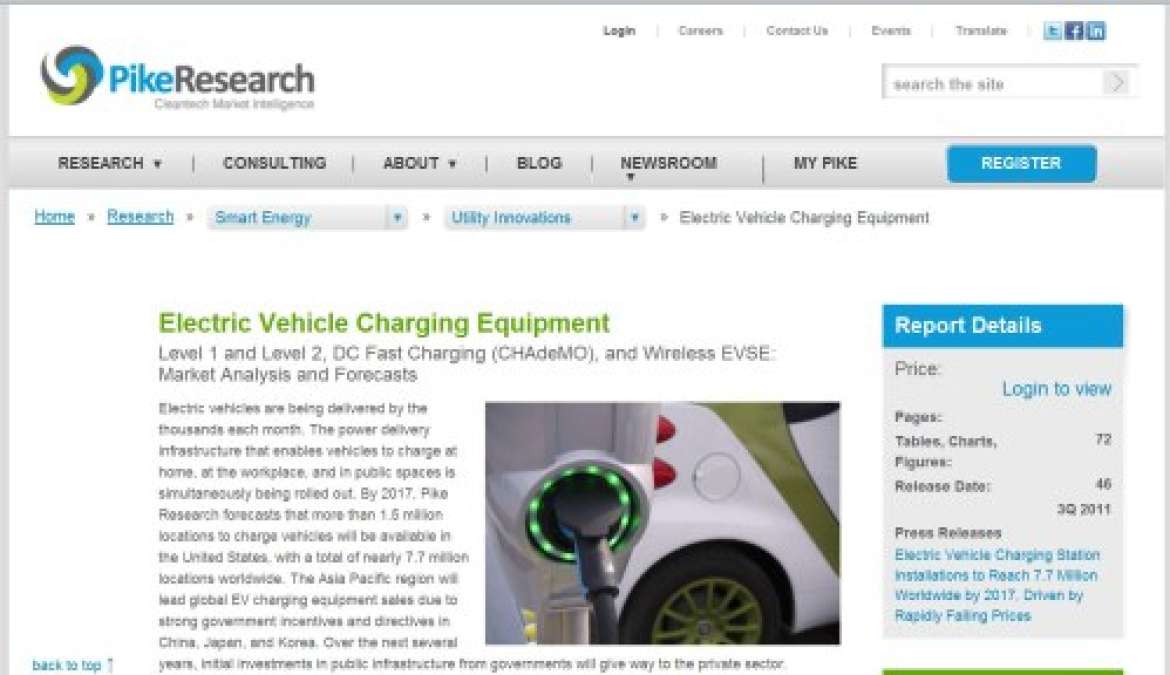The study also analyzes the key emerging sectors of direct current (DC) charging equipment and wireless EV charging stations. Key industry players are profiled as well as detailed charging equipment forecasts, segmented by world region and key countries, extend through 2017.
America is not alone, though. By 2017, Pike Research also forecasts a total of nearly 7.7 million locations worldwide. The Asia Pacific region, for example, will lead global EV charging equipment sales due to strong government incentives and directives in China, Japan, and Korea. Over the next several years, initial investments in public infrastructure from governments will give way to the private sector.
The “EV charging as a service” business model is also growing; as network operators look to provide electric vehicle supply equipment (EVSE) location and status information available on demand. These companies will integrate billing and aggregate power consumption to create new services that will help to stabilize grid operations and create new revenue streams.
As this business model grows, though, Pike Research anticipates that EVSE retail prices will fall by 37% through 2017 as competition from large electronics companies and volume production push down costs. As basic EVSE hardware becomes more of a commodity, manufacturers will integrate their equipment with external storage units, home energy management systems, and smart grid equipment to add value and increase their revenue.
In the meantime, key questions have to be addressed by government, utilities and EV manufacturers that may affect the transition toward the electrification of the automobile:
1) How many plug-in hybrid and all-electric vehicles will be sold through 2017?
2) How many charging stations will actually be installed through 2017?
3) What role will employers play in providing EV charging equipment?
4) When will wireless charging equipment begin to appear on consumer vehicles?
5) What are the business models for rapid DC charging?
6) What communication standards are necessary to enable remote smart charging of vehicles?
7) What are the primary business drivers for retailers to install EVSEs?
Torque News Assessment
For certain, the electrification of the automobile is here, albeit in its infancy. Be apprised there will be many forms of electrification, though, as hybrids provide better driving range; and light versions of electrification such as GM’s eAssist™ provide better efficiency for city-driving when combined with IC engines.
Nonetheless, do not throw out the IC engine just yet either. There is yet another derivation of the internal combustion engine yet to be brought into production; and I am not referring to HCCI, where a gasoline engine runs like a diesel. No, I once again (perhaps ad nauseum) refer to the split-cycle engine technology. This splitting of the 4-cycle engine into a cold and hot side can achieve thermal efficiencies yet to be harnessed by OEMs.
If there is any technology that will combat electrification, I fully believe it will be the air-hybrid derivation that comes from the split cycle engine. Two companies exist which have this technology: Scuderi and Tour; albeit the Scuderi seems to have an advance as far as a business model as it applies to automobiles, because it addresses gasoline, diesel and the air hybrid. Tour will likely target the smaller applications with its opposed piston design.
Then there is Achates Power with its opposed piston, two-stroke diesel. While this is not a split cycle, it bears noting for its direct application to heavy trucks.
Bottom line here is, the automobile is getting a technology dump as never before, with the IC engine still having the cost advantage over electrification due to the high cost of lithium-ion batteries. Only ultra-capacitors can help close the gap at this point.
-----------------------
About the Reporter: After 39 years in the auto industry as a design engineer, Frank Sherosky now trades stocks, futures and writes articles, books and ebooks like, "Perfecting Corporate Character," "Awaken Your Speculator Mind", and "Millennial World Order" via authorfrank.com. He may be contacted here by email: [email protected]
________________________________________________
Additional Reading:
Pike Research reports fuel cell market getting big boost from military
Cyclone Power awarded $1.4M from U.S. Army
Michele Bachmann fails to deliver how she would achieve 2 dollar gasoline
GM stock holders yet to benefit from 15 years in China
Toyota stock needs the 2012 Camry to be a hit
Dow Jones US Autos and Parts plunges lower with general market
CAR MBS 2011 reveals auto industry still uncertain on next IC Engine choices






Comments
What I don't understand is
Permalink
What I don't understand is where all of this electric is going to come from. Utilities across the nation are using energy conservation programs to reduce electric consumption because it's too expensive to build new power plants and here are the elctric vehicle people planning to run the nations cars on electric we don't have